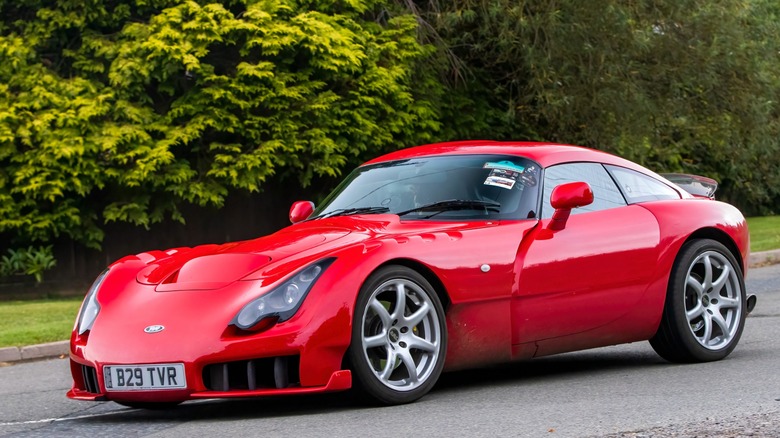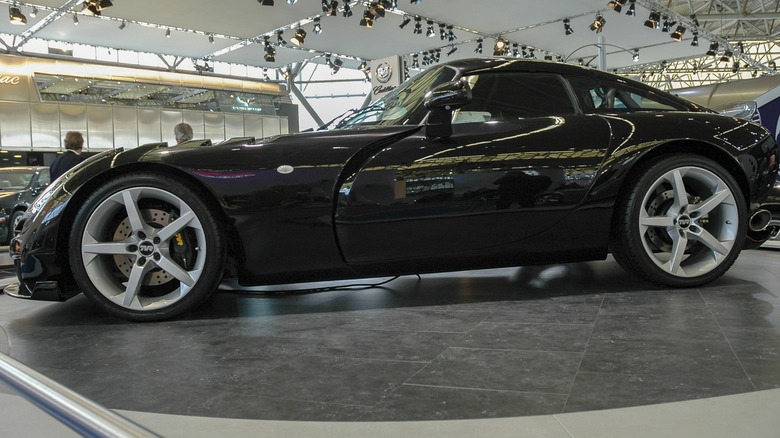
Sue Thatcher/Getty
When you talk about the history of sports cars, you’d be remiss not to touch on TVR. Born in the aftermath of World War II by Trevor Wilkinson as TrevCar Motors, the British manufacturer has developed a line of vehicles known for their sleek, angular, lightweight design that complements the speed and veracity of their powerful engines.
Since the company’s inception and the development of its first car running on a Ford 100E engine, TVR’s lineup has only progressed. Designed with speed in mind, TVR relied heavily on other manufacturer engines, like Buick’s Rover V8, which drove the TVR Chimaera right until its last production model in 2003.
While TVR is still hard at work producing new and impressive rides, its line has seen a number of speedsters that continued to build upon Wilksonson’s original vision. The following six TVR models, starting with the fastest, have marked the speediest options in the manufacturer’s long and storied past.
To build this list, we looked primarily at each vehicle’s acceleration from zero to 60 mph.
6. TVR Tuscan Speed Six – 3.9 seconds
Depending on the source, there’s a fluctuation in recorded times for TVR’s Tuscan Speed Six. However, the most commonly cited acceleration is between 3.6 and 3.9 seconds, which is more than fast enough to stand up to some of the brand’s fastest models.
Produced from 1999 to 2006, this sleek ride had a beautiful aerodynamic design, driving home its sports car status. Appealing to a breadth of drivers, the Tuscan Speed Six was released as both a Targa top and convertible top, with either a 3.6-liter, 4.0-liter, or 4.2-liter engine capable of hitting 185 mph. Regardless of the model, they all sported a five-speed manual transmission.
A 2020 article for a post-2003 4.0 L Tuscan S cited that tests on the striking TVR model saw it top 60 mph in under four seconds. That alone may not be enough to warrant the $99,000 price tag it was selling for, but it’s certainly a selling point for this redux of the 1967 TVR Tuscan.
[Featured image by Vauxford via Wikimedia Commons | Cropped and scaled | CC BY-SA 4.0]
5. TVR Sagaris – 3.9 seconds

Sjoerd Van Der Wal/Getty
After Wheeler left TVR, Russian banker Nikolai Smolenski purchased the company, and under this new management, the Sagaris prototype, which was designed under Wheeler, was put into production. From 2005 to 2006, TVR manufactured 211 of the sleek coupe, complete with its bubble roof, inline-six engine, and 406 hp at 7,000 rpm output.
The small speedster retained TVR’s need for speed, hitting a high of 185 mph in only 3.7 to 3.9 seconds, depending on the source. During Autocar’s road test, it hit 60 mph at 3.9 seconds, while other outlets, like Independent, tout the faster acceleration. According to Autocar, the Sagaris «was easily the best TVR ever.» The outlet noted that the ride was comfortable and firm and remained responsive even at its highest speeds.
Though Smolensky promised a revamp of the Sagaris with the Sagaris 2, before he could deliver, the banker moved on, and the manufacturer shifted focus to the Griffith.
4. TVR Griffith 200 – 3.8 seconds
Not to be confused with the 2024 rerelease, the Griffith 200 was the brainchild of Andrew «Jack» Griffith, a Ford dealer from Long Island who sought to go up against the Shelby Cobra. With help from TVR, which supplied the tubular chassis, braking system, coil-spring transmission, and a Grantura Mk. III GRP body shell, Griffith was able to realize his dream.
The Griffith 200, which went into production in 1963, was equipped with a Ford V8, capable of hitting 271 hp and a top speed of 140 to 155. Under peak performance, the Griffith 200 could hit 60 mph in 3.8 seconds.
When production vehicles were brought to the United States, they dropped the TVR name, though British models were still sold as the TVR Griffith 200. While the vehicle did rival the Cobra in design, TVR’s lack of notoriety, particularly in the United States, ensured that it flew under the radar.
[Featured image by Valder173 via Wikimedia Commons | Cropped and scaled | CC BY-SA 4.0]
3. TVR T400R – 3.7 seconds
Serving as the framework for the Typhon, which we’ll touch on shortly, the T400 R started as the Tuscan R. Produced during the late 1990s, the T400R was developed as TVR’s latest entry for the Le Mans Series. From 2001 to 2006, the T400R took to the track, powered by a six-cylinder inline alloy engine.
The T400R, capable of hitting 400 bhp at 7,000 rpm, rounded the track at an impressive 200 mph. Though its predecessor, the Cerbera Speed 12, managed a zero to 60 mph acceleration of under three seconds, the T400R was a little slower, topping out at around 3.7 seconds.
The T400R performed well at Le Mans during its run, especially for being TVR’s first attempt at the tracking race, but it didn’t manage to win. Only seven T400R racing chassis were put into production from 2000 to 2004.
[Featured image by Daily Sports Car via Wikimedia Commons | Cropped and scaled | CC BY-SA 4.0]
2. TVR Typhon – 3.7 seconds
Dubbed the fastest of TVR’s production vehicles, the Typhon, a spin on the T400R, does earn its space higher on this list. However, many outlets only consider its rated top speed of 200 mph and not the fact that it still took 3.7 seconds to hit 60 mph.
Like the T400 R and the Cerbera Speed 12, the Typhon was developed as part of TVR’s Le Mans lineup. Looking at the design and materials of other Le Mans vehicles, Wheeler thought it best to equip the Typhon with a steel tubular frame and complete roll cage. The hope was that this framework would keep the car stable at its top speed while the roll cage would withstand any incidents on the track.
Only three Typhon models were produced from 2000 to 2006, equipped with a 4.0 or 4.2-liter engine that could produce up to 600 hp. Before the Typhon could be downgraded from its racing status and sold to consumers, Wheeler left TVR, taking his vision with him.
[Featured image by Tim Morris via Wikimedia Commons | Cropped and scaled | CC BY-SA 4.0]
1. TVR Cerbera Speed 12 – 2.9 seconds
Produced as a GT1 racing series iteration of the TVR Cerbera line, the Speed 12 was a marvel on the road. That is, so long as TVR didn’t overstate the vehicle’s performance for the sake of showmanship.
Equipped with a 7.73-liter V12, the Cerbera Speed 12 was expected to be powered by 1,000 hp. However, during in-house testing, engineers damaged an input shaft, resulting in a janky improvisation. Instead of testing the entire engine in one shot, they had to test individual cylinder banks. Both banks ranked at 480 hp, resulting in 960 hp in total.
Based on the manufacturer-stated specifications, the TVR Cerbera Speed 12 was able to run from zero to 60 mph in 2.9 seconds. Though there are cars that can jump to 60 mph in just under two seconds, if TVR’s specs were correct, the Cerbera Speed 12 would be a considerable improvement from its more standard models. However, that figure has never been verified beyond TVR.
After its run at the GT1 racing series was cut short by updated regulations, the Speed 12 was scrapped. Allegedly, then TVR head Peter Wheeler had driven the Speed 12 and deemed it too wild for production.
[Featured image by MrWalkr via Wikimedia Commons | Cropped and scaled | CC BY-SA 4.0]